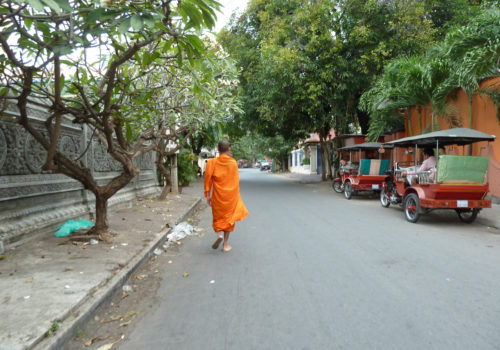It is strange to arrive in a city in mourning, in a country that has such a tragic past. It is impossible to come to Phnom Penh without thinking about the millions of this city’s inhabitants that were evicted in two days, deported, tortured, assassinated, and yet, nothing of that sinister past remains. This city and its people are, like almost everywhere else in Asia, bustling to survive.
It is the third time that this Photo Festival is being held in Phnom Penh. More than experiment by the Artistic Director, Christian Caujolle and the local French Cultural Center, it is the confirmation of their idea. The festival was originally designed to help train future professionals, and provide a fertile meeting ground for active photographers. It is not a new idea, but making it work can often be difficult, especially in a country lacking any particular photographic tradition, with an old-fashioned cultural environment, without financial support and that has, unfortunately, other priorities. Nevertheless, 13 international photographers and 10 Cambodian photographers are on exhibit in a very popular location, the Royal University of Phnom Penh (15,000 students). Photographers working together on the same theme will be able to meet and exchange ideas. The name of this experience is very evocative, “Intersection”. It is one of the principles of this Festival, no workshops, no student professor dialogue, everything is to be learned from exchanging.
We arrived just prior to the Festival’s official opening, and had the opportunity to visit most of the exhibition locations. I am writing with a smile in the scorching heat (32° in the shade), that the Festival is young, serious, and engaging. Presenting pictures by Raphaël Dallaporta of landmines in a country infested by them, or the series by Kent Klich about the Gaza strip after an Israeli attack, so efficiently describing the horrors of war in a country like Cambodia whose internal and external wars have provoked such suffering, is very daring. The Cambodian photographers have an astonishingly sharp eye, taking an incisive look at themselves, at their country, the magnificent portraits by Sovan Philong, dignified, and the strange black and white shots by Chhi Taigchhea on the architecture of the Royal University of PP, the stupefying and modest still lives by Heng Ravut are as many good surprises proving that photography is a fantastic learning ground. Being at last night’s outdoor projection at the French Church of Phnom Penh, in a fervent crowd of adults and children is all it took to be definitively seduced by this Festival.
Michel Philippot
















